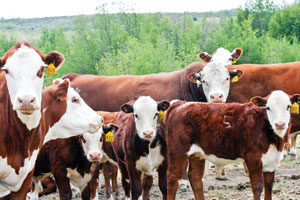The most economical option for a consistently healthy herd is to maintain adequate body condition scores (BCS) throughout the year.
Top-performing cattle often have a consistent BCS between 5.5 and 6 on a nine-point scale. If cows fall below a BCS of 5, reproductive and performance issues can be more probable.
A consistent BCS between 5 and 7 is also the most cost-effective position for a herd to be in. If cattle producers allow their cattle to fall below a BCS of 5, adding the pounds back onto the cow is challenging and costly.
Thin cows can create performance issues. Underconditioned cows have greater potential for dystocia at calving.
Calves that experience dystocia often suffer from severe respiratory acidosis and are less efficient at absorbing colostral immunoglobulins, compromising their immune systems.
These problems are compounded as thin cows typically have difficulty providing enough nutrients (both quantity and quality) to young calves.
When an underconditioned cow is working to provide nutrients to her calf, the breeding period can also be more challenging.
Thin cows are prone to a prolonged open period following the 60- to 85-day post-calving window, lower conception rates and decreased production through lactation.
These side effects result in fewer weaned marketable pounds for the calf at the cow’s side and later-born calves the following year.
Studies at Purina Animal Research Center in Gray Summit, Missouri, support these findings with substantial numbers.
A cow in better body condition can produce an average of three pounds more milk per day and grow calves with 0.4 pound higher average daily gains for an additional 82 pounds of marketable weaning weight.
Research also shows that a cow in adequate body condition will rebreed 18 to 27 days sooner and have 10 to 20 percent higher conception rates than underconditioned cows.
Additional studies have found that a low BCS can impact the calf the cow is carrying in utero and the calf’s long-term productivity.
To avoid the pitfalls of underconditioned cattle and maximize the benefits of consistent condition, herds should be fed to maintain a BCS of 5.5 to 6 through all stages of production.
Feeding adequate protein and mineral levels throughout the year is a more economical and productive option than attempting to regain a cow’s condition after she becomes thin.
Two primary ways to stay in the “safe body condition zone” are energy and protein supplements. These additives have been shown to help producers better utilize available nutrients in a ration as the cow works to maintain her energy levels.
Mature lactating cows may require 10 to 12 percent protein in their rations depending on milk production and body size to maintain a BCS of 5.5 to 6.
Comparatively, a cow in her late second or early third trimester that has weaned a calf may only require 7 to 8 percent protein.
Due to this year’s drought (and traditional seasonal fluctuations of fields and pastures), the nutrients provided through forages can vary significantly from one week to the next.
Therefore, the protein level needed by the cow may not always be readily available through forages.
Protein supplements have been proven to help cattle best utilize the energy found in forages. These products can supply additional protein to the cow when forage nutrients are subpar.
Studies have found that offering protein supplements as a free-choice liquid or tub supplement throughout the year is more economical than offering protein cubes when the animal becomes underconditioned.
Research from Purina Animal Nutrition shows that more energy is needed to return a cow to an adequate BCS than what is needed to maintain a consistent BCS throughout the year.
In this particular research trial, one group was fed to maintain BCS while another group of cattle was fed free- choice protein supplements.
Cows in the first group fell below adequate BCS when protein supplements were removed from the ration and then needed additional energy to regain condition.
The economic advantage was measured in the group that was fed to maintain body condition scores consistently.
The group offered supplemental protein cubes for 150 days consumed an average 563 pounds of supplement per cow per year while those offered free-choice supplement consumed 437 pounds of supplement per cow.
The added supplement resulted in a cost of more than $35 per cow per year more in the limit-fed cattle than the cows fed free-choice protein supplements.
Benefits weren’t just limited to reduced feed costs in the trial. The group offered free-choice protein supplement averaged 8 percent higher pregnancy weights and produced weaned calves that averaged 94 pounds more than their limit-fed counterparts.
After combining the decreased cost of supplement and the advantages in production, the net return per cow was $169.22 higher for the free-choice-protein-supplement group that was fed a sustained nutrition program versus the conventional cube feeding program.
The returns of consistent protein supplementation can also be translated to herds that transition to corn stalks or total mixed rations (TMR) during the winter months.
Products that are mixed into these rations routinely can prevent cows from becoming too thin during the winter.
Producers in these situations should work with their local nutritionist to decide what products and programs will fit their herd’s needs. Producers are also encouraged to provide a balanced mineral mix.
The combination of a balanced mineral mix, adequate protein supplements and stable forage levels can promote consistent production within the herd.
Ultimately, maintaining a consistent BCS through all seasons saves producers money and promotes the long-term viability of the herd.
For additional information on body condition scoring and protein and mineral supplements, Click here.
PHOTOS
TOP RIGHT: Studies show stronger body condition scores help improve a calf’s long-term productivity, not just during the period in utero. Photo courtesy of Progressive Cattleman staff.
BOTTOM RIGHT: Pastures and supplied forages often provide variable nutrients to beef cow herds. To keep production steady and herd health high, beef cows should be supplemented throughout the year to promote consistent body condition scores. Photo courtesy of Purina Land O’Lakes.













